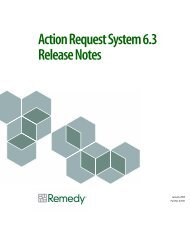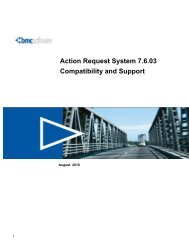BMC Remedy Action Request System 7.6.04: BMC Remedy Mid Tier ...
BMC Remedy Action Request System 7.6.04: BMC Remedy Mid Tier ...
BMC Remedy Action Request System 7.6.04: BMC Remedy Mid Tier ...
Create successful ePaper yourself
Turn your PDF publications into a flip-book with our unique Google optimized e-Paper software.
<strong>BMC</strong> <strong>Remedy</strong> <strong>Action</strong> <strong>Request</strong> <strong>System</strong> <strong>7.6.04</strong><br />
168 <strong>BMC</strong> <strong>Remedy</strong> <strong>Mid</strong> <strong>Tier</strong> Guide<br />
(Optional) To limit the list of forms to those that are already used in other<br />
reports, select Forms Used in Existing Reports. This can speed up retrieval of the<br />
list of forms, but any form that is not already used in some report does appear<br />
on the list.<br />
To find the form quickly, type the first few letters of the form name into the field.<br />
For example, type “Sample” to select from the list of forms related to the Sample<br />
application.<br />
5 Select or deselect the “Add default fields and sort order” check box:<br />
Selected—Fields that appear in the form’s results list after a search are<br />
automatically added to the report definition, along with the default sort order.<br />
You can remove or change these fields and sort order later if necessary.<br />
Not selected—No fields are added to the report definition automatically.<br />
6 In the Name field, type a name for the report. This field is required.<br />
The report name must be unique. The maximum length is 128 characters. Also, you<br />
cannot change the name of the report after you exit this screen, so use care in<br />
assigning a report name.<br />
NOTE<br />
Each report must have a unique Name/Locale combination. For example, two<br />
reports can both be name “Monday”, if the locale for each report is different.<br />
7 Click OK.<br />
If you selected the Web report type, the Report Console report designer screen<br />
appears. Build the Web report definition using the following procedures:<br />
“Defining a Web list report” on page 168<br />
“Defining a Web chart report” on page 170<br />
“Using a query in a Web report” on page 173<br />
If you selected the AR <strong>System</strong> report type, the ReportCreator form opens instead.<br />
See “Defining AR <strong>System</strong> reports” on page 177.<br />
Defining a Web list report<br />
List reports are presented in the form of a table, with one column for each field that<br />
you add to the report. One column of the report includes a link to the record in the<br />
underlying form (assuming the form properties allow this), so you can open the<br />
record and view the data underlying the report.<br />
For example, a partial report based on the Sample:Classes form might list all class<br />
records in the form, showing the class title, location, instructor and number<br />
enrolled.





